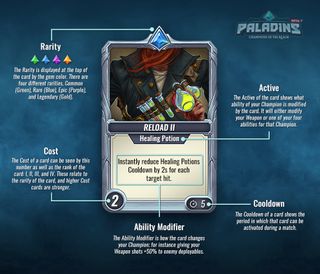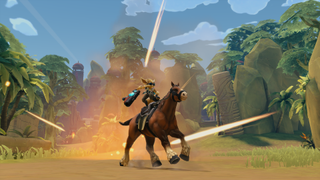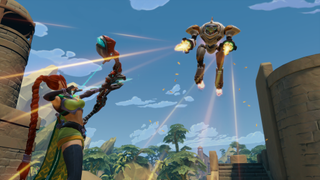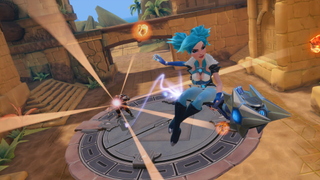A beginner's guide to Paladins' card system
Pay attention to your deck to boost your win rate.

Comparisons between Paladins and Overwatch aren't unfounded. Paladins is a team-based shooter with unique heroes; Overwatch is a team-based shooter with unique heroes. Paladins asks players to complete objective-based missions; Overwatch asks players to complete objective-based missions. You get the idea. But regardless of those similarities—and that’s not even considering the parallels between each game’s heroes—Paladins and Overwatch are not the same game. There are a few systems in each that really set them apart. To start with, Paladins has horses, and every character gets to ride them. Even the dragon.
Paladins has 17 heroes, each with their own distinct abilities. Ruckus is a little goblin guy that operates a mech suit. Fernando is a knight that acts as a tank. Kinessa is a sniper who can throw down damage dealing mines—so on, and so forth. Though each character does have their own separate thing going on, it’s not particularly easy to divide Paladins characters into clearly defined roles. (The game does try, though, but they’re still fairly vague—damage, front line, support, flanker.)
Paladins’ deck-building system is where it differentiates itself most notably, allowing you to craft a character to do what you need it to do in each particular game. That doesn’t mean you don’t have to pay attention to your team's lineup while drafting heroes, though. Nor can every character do everything. Some characters are better for flanking, while others are clearly support, as developer Hi-Rez has outlined. Paladins’ deck-building feature, though, allows for a bit more variation when it comes to each player’s particular role as each character.

Deck-building
Those familiar with Overwatch will be able to jump right in—just shoot things and move the payload—but it is important to consider how your card lineup can change your role. But if you don’t feel like dealing with that as soon as you jump in, you won’t have to—Paladins has a premade starting deck for us lazy folk.
If you’re interested in really taking advantage of the stuff that separates Paladins from other games like it, however, you’ll want to pay attention to your cards. In fact, you’re likely at a disadvantage if you aren’t messing around with your deck. You can get new cards by crafting them with gold and crystals or by opening in-game chests. The cards you do have—and the ones you don’t—are displayed in the Champions tab. Clicking each character will pull up another menu, and under loadouts you’ll find your decks. If it’s your first time there, you’ll see your basic deck along with five other slots.
Decks are made up of five cards worth a total cost of 12 points. More expensive cards are stronger and likely more important to your build. Everything the cards add is passive, meaning that the given buffs apply automatically. You don’t have to push any buttons in-game.

Building specific decks differs from character to character, as each has their own custom cards aligned to their abilities. Your choice of deck will likely change depending on your team’s lineup—so build a few for different situations! For instance, say you’re playing as the healer Ying. She’ll never be a major damage dealer, but you can use cards to buff the damage she can do. So while your main job will always be healing your team, you can step up as Ying to do extra damage if you need to.
PC Gamer Newsletter
Sign up to get the best content of the week, and great gaming deals, as picked by the editors.
With Skye, who is considered a flanker in Paladins, your decks should change depending on your play style. Do you like a speedy character, who can dash in and out of fights? Want to be someone who isn’t spending all their time flanking, but instead rushing into the front line if you need to? You’ll want to choose cards that prioritize speed. Prefer to stay in the shadows, always hidden from view? Balance your cards to optimize Skye’s stealth modes—specifically cards that enhance Hidden or Smoke Screen.
Fernando—a front line tank—can be used in bunch of different strategies depending on how your team is made up and how you want to play.
Certain cards can really beef up your already hefty shield, but that leaves Fernando weaker—still, it’s a good option if you’ve got a lot of damage on your team. Other builds play up Fernando’s damage dealing abilities and speed, you can chase down squishy enemies. With that, you won’t be able to soak up as much damage before dying than if you went pure tank. You will be able to get back to the fight fast, though!
Read all the cards. Play around with options. See what works for you in different situations. Have a few different builds available, all of which play to your strengths. As I said, you can just pick these at random, but you’ll be at a disadvantage from the start. You can be good at Paladins with a bad deck build, but you can be great with one.

Burn cards
Burn cards are purchasable in each match by using credits earned while playing. Since you can’t change heroes in Paladins to counter the other team, like you would in Overwatch, you’ll use burn cards to buff your character in a reactive way. All burn cards are the same for each character on both teams, and they’re separated into four types: attack, defense, healing, and utility.
Say you’ve got no healer, or even worse—a healer who is doing nothing. There’s a burn card called Kill to Heal that gives you health when you get a kill. Maybe you’re Skye and you’ve prioritized speed with your deck, and doing a really good job rushing in and out of fights. Get faster by choosing Nimble, a burn card that boosts movement speed. Or maybe there’s a super annoying Skye on the other team—someone with a perfect stealth deck. That’s when you’ll want to use a defense burn card called Illuminate, where the range at which you see stealth targets is increased.
You can continue buying burn cards throughout the match, and their effects last for the duration of a round. Only one card from each group is buyable, though, so choose wisely. However, you can stack one card, upgrading its particular effect a bit each time. Each can be upgraded three times, then you’ll have to move on to another type, if that’s what you choose to do.

Go forth
From here, you’ll want to do the things you’ve learned in other, similar team-based games. (Ahem.) Actually play supports. Tanks, too. You don’t always have to be the damage dealer! Listen to the game—when characters with scary ultimates are around, they’ll announce it. Skye, in particular, has got powerful bomb with a pretty big area of impact. She’ll let you know that it’s coming, though: “Time’s ticking!” So when you hear stuff like that, get out of the area. And while maybe you’re avoiding the area where Skye dropped her bomb, go annoy the others instead.
Shoot everything. See things on the ground? (Kinessa drops mines that deal damage and slow enemies). Shoot those! There’s unlimited ammo, so you’ve really got nothing to lose.
Most Popular

